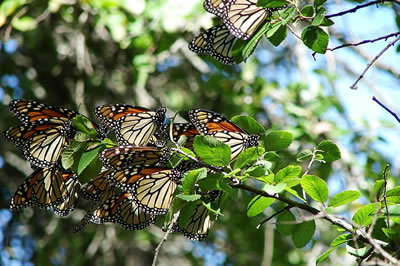Butterflies and Moths

Facts about creatures
- Home
- Animal Classification
- Animal Habitats
- Amphibians
- Arthropods
- Bats
- Birds
- Carnivorans
- Cetaceans
- Chordates
- Crustaceans
- Dinosaurs
- Diprotodonts
- Elephants
- Fish
- Golden Mole
- Insects
- Lagomorphs
- Mammals
- Mammal Teeth
- Marsupial Mole
- Metamorphosis
- Mollusks
- Primates
- Reptiles
- Rodents
- Ruminants
- Soricomorphans
- Tenrec
- Tetrapods
- Vertebrates
Butterflies and Moths
Butterflies and moths are insects that belong to the order Lepidoptera. They have two pairs of membranous wings that are covered in scales.
The name Lepidoptera is Greek for “scale wing”.
Butterflies and moths have many different wing patterns and colors.
Lepidopterans undergo complete metamorphosis.


The larvae of moths and butterflies are known as caterpillars.
Most caterpillars are herbivores, but some are carnivores and eat other insect larvae, including other caterpillars.
Some caterpillars eat crops and are agricultural pests.
Clothing moth caterpillars eat fiber from clothing. They can turn keratin, a protein that is found in wool, fur, hair, nails and claws, into food.
The silkworm is the caterpillar of the moth Bombyx mori. Its cocoon is made of silk.
Most adult lepidopterans live on nectar from flowers. They have a long mouthpart, known as a proboscis, or haustellum, that is used for sucking nectar.
Some adults do not eat at all and their mouthparts are reduced.
Butterflies and moths play an important role in pollination.
Some species migrate seasonally.
The monarch butterfly migrates from Canada and the northern United States all the way to Mexico.
Death’s Head Hawkmoth
The death’s head hawkmoth gets its name from the white marking on its back that resembles a skull.
It raids beehives to obtain honey.
In many parts of the world, the death’s head hawkmoth is considered an omen of death.
It plays a part in the movie The Silence of the Lambs and in the novel on which the movie is based.
Apple Worm
The larva of the codling moth is known as the apple worm or apple maggot. It attacks apple trees and other fruit trees.
If you bite intp an apple and find a worm inside, the “worm” you have found is really a codling moth caterpillar.
The female codling moth lays her eggs on apples that have just begun to grow.
When an egg hatches, the caterpillar eats its way into the apple and remains inside, eating and growing.
Eventually, it gnaws its way out and then spends the winter hiding in a crack in tree bark.